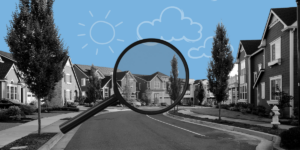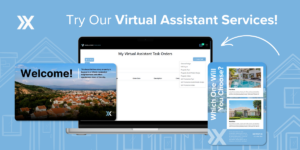Uncover the secrets to successfully guiding clients in finding their perfect neighborhood with our 5 essential steps. In this guide, we’ll explore how to understand your client’s needs, gather crucial data, and present your findings engagingly and effectively.

Finding the perfect house is not just about the property itself; it’s also about finding the right neighborhood. In the sun-kissed state of Florida, a diverse array of communities awaits discovery. As a Real Estate agent, your mission is to unveil these hidden gems and cater to each client’s unique preferences.
After all, where you live can have a significant impact on your quality of life. That’s why Real Estate agents must know how to locate ideal neighborhoods for their clients. In this article, we’ll share a deep dive into the process, step by step, offering valuable insights, questions, tips, and marketing ideas to help you create unforgettable experiences for your clients.
1. Uncover Your Client’s Living Preferences
The first step in locating ideal neighborhoods is to understand your client’s needs and preferences. To successfully guide your clients in finding their ideal home, it is crucial to build a strong rapport and genuinely understand their needs.
As a Real Estate agent, your role is to listen attentively, empathize, and show genuine interest in their preferences. This will not only create trust but also facilitate open communication. This will help you narrow down your search and focus on communities that are most likely to meet their requirements.
Daily routines
Understanding your client’s daily routines and hobbies is essential in identifying the perfect area. If they enjoy outdoor activities, look for neighborhoods with parks and walking trails. Consider their work situation, too, as proximity to their workplace or public transportation can be a deciding factor.
Questions to ask:
- What are your favorite leisure activities, and how important are they in your daily life?
- How long is your average daily commute to work, and would you like to reduce it?
- Are you interested in living in a walkable neighborhood with easy access to shops and restaurants?
Family size and dynamics
Inquire about your client’s family structure, including the number of children, their ages, and school requirements. Ask about their preferences for specific school districts or educational requirements. Additionally, explore their future plans, such as having more children or accommodating aging parents. This information will help you find a neighborhood that meets their family’s current and future needs.
Questions to ask:
- How many children do you have, and what are their ages?
- Are there any specific school districts or educational requirements you prefer?
- Would you like to live in a neighborhood with playgrounds and age-appropriate facilities for your children?
Budget and affordability
Discussing your clients’ financial constraints and budget preferences is essential. This will help you find properties within their price range and ensure a smooth home-buying process. Don’t forget to consider ongoing expenses like property taxes, homeowner association fees, and maintenance costs.
Questions to ask:
- What is your preferred price range for a home?
- Are there any specific mortgage or financing options you prefer?
- How important is property tax and homeowner association fees in your decision-making process?
Lifestyle preferences
Determine your clients’ preferred community atmosphere by discussing their preferences for urban, suburban, or rural settings. Find out if they prefer a quiet residential area or a more bustling area with shops and restaurants nearby. Ask about their preferences for walkability, access to public transportation, and the overall vibe of the community.
Questions to ask:
- Do you prefer a quiet residential area or a more bustling area with shops and restaurants nearby?
- Would you like to live in a gated community or a more open neighborhood?
- How important is proximity to nightlife, entertainment, and cultural attractions?
Climate considerations:
As Florida has a warm and humid climate, discuss your clients’ comfort level with the weather. Inquire about their preferences for proximity to beaches, waterfront properties, or other climate-related factors. Address any concerns they may have regarding natural disasters, such as hurricanes or flooding, to ensure their peace of mind.
Questions to ask:
- Are you comfortable with Florida’s warm and humid climate?
- Do you prefer a neighborhood with easy access to beaches or waterfront properties?
- Are there any specific natural disaster concerns you have, such as hurricanes or flooding?
Amenities and community facilities
Understanding your clients’ preferred amenities and community facilities is crucial for finding the perfect community. Ask about their essential amenities, such as gyms, parks, swimming pools, and shopping centers. Discuss their preferences for nearby schools, as quality education is a top priority for many families.
Questions to ask:
- What amenities are essential for you, such as gyms, parks, or swimming pools?
- How important is the quality and proximity of schools for your family?
- Do you have any specific religious or cultural preferences that may influence the neighborhood choice?
Future plans
Discuss your clients’ long-term plans, such as retirement or relocation, to ensure the chosen area aligns with their future goals. This may involve adjusting your search to accommodate any potential changes in their lifestyle or preferences. By understanding their future plans, you can help them find a neighborhood that will continue to meet their needs as they evolve.
Questions to ask:
- Do you plan to retire in Florida? If so, what kind of community would you prefer for retirement?
- Are there any future relocation plans that may impact your preferred neighborhood?
Remember to pay attention to body language, tone, and nonverbal cues during conversations. This will help you better understand your client’s true desires and provide tailored recommendations. By asking these questions and actively listening to your client’s responses, you’ll be able to gain a better understanding of their needs and preferences, ultimately helping you find the perfect community for them.
2. Exploring Potential Neighborhoods
Once you have a better understanding of your client’s needs, it’s time to start researching neighborhoods. To help your clients find the ideal area in Florida, it’s crucial to conduct thorough online research and engage with the community. By following these tips, you’ll be better equipped to evaluate places based on your client’s preferences.
Research Local Schools:
Parents often prioritize the quality of education when choosing a neighborhood. Utilize websites like GreatSchools and Niche to research local schools and their performance ratings. This information will help you identify the best school districts and educational options in the area, ensuring your clients’ children receive a top-notch education.
Explore Community Events and Attractions:
A vibrant community is essential for many homebuyers. Use platforms like Eventbrite and Visit Florida to discover local events, cultural attractions, and recreational activities. Share this information with your clients to help them visualize their life in the neighborhood and determine if it aligns with their interests and lifestyle.
Analyze Walkability Scores and Bike-Friendliness:
For clients who prioritize eco-friendly transportation and a walkable lifestyle, use Walk Score and Bike Score to analyze the neighborhood’s walkability and bike-friendliness. High walkability scores indicate that daily errands can be accomplished without a car, while bike-friendly neighborhoods offer safe and convenient routes for cyclists. This information will help you identify communities that cater to your clients’ preferences for an eco-conscious and active lifestyle.
Check Demographics:
Understanding the demographics of a community can provide valuable insights into its character and suitability for your clients. Websites like City-Data and AreaVibes offer detailed information on community demographics, including age distribution, income levels, and ethnic backgrounds. This data can help you identify areas that align with your clients’ cultural preferences and social needs.
Visit Neighborhoods at Different Times of the Day:
Encourage your clients to visit potential communities at various times of the day, including weekdays, weekends, and evenings. This will help them experience the area’s vibe and understand how it changes throughout the day. They can observe traffic patterns, local businesses, and community activities, further refining their neighborhood preferences.
Attend Local Events and Meet the Neighbors:
Encourage your clients to attend local events, such as farmers’ markets, community gatherings, or association meetings. This will allow them to meet the residents, learn about the community’s values, and build connections that could potentially lead to valuable insights about the area.
You can learn about upcoming events, local initiatives, and other community news. This can help you stay up-to-date on what’s happening in the area and provide your clients with the most current information.
3. Data Analysis: The Power of Insights
After you’ve gathered some initial information about neighborhoods, it’s time to start analyzing the data. Data analytics plays a crucial role in neighborhood research. To help your clients make an informed decision, it’s essential to analyze data and consider key factors when comparing neighborhoods. Here’s a more in-depth look at some crucial aspects to evaluate:
1. Crime Statistics and Safety Measures:
Ensure the safety of your clients by researching crime rates and safety measures in the neighborhoods you’re considering. Visit the local police department’s website or contact them directly for this information. Analyze crime trends and compare them to the state and national averages. This will help you identify any potential concerns and provide valuable insights to your clients.
2. School District Rankings and Ratings:
If your clients have children or plan to start a family, the quality of local schools is a significant factor. Utilize websites like Niche and GreatSchools to research school district rankings and ratings. Compare these ratings with your client’s preferences and expectations to help them make an informed decision.
3. Commute Times and Transportation Options:
Evaluate the local transportation infrastructure, including bus routes, train schedules, and bike lanes, to determine the ease of commuting and daily travel. This information will help you assess the neighborhood’s suitability for clients who prioritize convenience and accessibility.
Data Analytics Tools and Platforms
To make the most of your neighborhood research, familiarize yourself with data tools and platforms specific to Florida neighborhoods. Some valuable resources include:
a. Florida Realtors®: This platform offers market data, statistics, and reports on Florida’s housing market. By analyzing this information, you can identify trends and growth potential in various neighborhoods.
b. Florida Housing Data: This comprehensive resource provides housing data on affordability, foreclosure, and demographics. It can help you understand the financial aspects of different neighborhoods and support your clients in making informed decisions.
c. NeighborhoodScout: This website offers detailed neighborhood information, including crime rates and school ratings. It can assist you in comparing neighborhoods based on various factors and provide a more in-depth understanding of each area.
Comparing Using a Spreadsheet
To simplify the comparison process, create a spreadsheet that lists key factors for each neighborhood under consideration. This may include property values, growth potential, and other aspects that matter to your clients. By organizing this information, you’ll be able to provide a clear and concise comparison, making it easier for your clients to make a well-informed decision.
Future Development Plans
Assess the potential impact of future development plans on the communities you’re evaluating. This may include infrastructure projects, zoning changes, or new construction. By understanding how these factors could influence the neighborhood’s character and property values, you’ll be better equipped to advise your clients on the long-term implications of their decision.
By thoroughly analyzing data and considering these key factors, you’ll be better prepared to help your clients find the ideal area in Florida. This comprehensive approach will ensure that you identify areas that align with their preferences, lifestyle, and future plans, ultimately leading to a successful and satisfying home-buying experience.
4. Presenting Neighborhood Options
After analyzing data and identifying potential neighborhoods, it’s crucial to present these options engagingly and compellingly. Be sure to explain the potential benefits and drawbacks of each community. For example, you might explain that a neighborhood with a high crime rate also has a lot of affordable housing, or that a neighborhood with a lot of traffic also has easy access to major highways.
As a Pro-Assist Plan member, you can leverage Virtual Assistant Services to craft visually stunning presentations that guide your clients through their investment journey, allowing them to visualize the neighborhood and have all the necessary information to make an informed decision.
In addition, incorporating storytelling techniques can help your clients envision themselves living in the community. Here is a more detailed exploration of these strategies:
Showcase Neighborhoods
To showcase neighborhood features and amenities, leverage Virtual Assistance Services like creating videos, reels, and engaging presentations. These resources can help clients get a better sense of the neighborhood’s atmosphere, even if they cannot visit in person. Some ideas include:
a. Creating Videos: Showcase the area’s highlights, such as parks, restaurants, and local events, through short videos. These can be shared on social media platforms or sent directly to clients.
b. Social Media Reels: Use Instagram or Facebook reels to showcase the neighborhood’s unique aspects, such as community events, local businesses, or picturesque landscapes. These short, engaging videos can capture your clients’ attention and spark their interest.
c. Designing interactive neighborhood maps: Create interactive maps that highlight key features, such as schools, parks, and shopping centers. Clients can explore these maps on their own or during virtual meetings, helping them visualize the neighborhood’s layout and convenience.
Storytelling in Presentations
Storytelling is a powerful tool that can help your clients connect emotionally with the neighborhood and envision their life there. Use storytelling techniques to create a more immersive and engaging presentation. Some ideas include:
a. Highlighting local history: Share the history of the neighborhood and its significance to the community. This can help clients feel a deeper connection to the area and understand its cultural context.
b. Introducing residents and local businesses: Share stories of the people who live and work in the neighborhood. This can help clients envision themselves as part of the community and understand the area’s social fabric.
c. Describing daily life in the neighborhood: Paint a vivid picture of what life in the community might look like for your clients. Describe typical routines, such as morning walks in the park, grabbing coffee at a local café, or attending community events. This can help clients visualize themselves living in the area and imagine their daily life.
Marketing Ideas for Presenting Neighborhoods
To effectively showcase neighborhoods to clients, consider the following marketing ideas:
a. Create a brochure: Develop a visually appealing brochure that highlights the key features and benefits of each neighborhood. Include photos, maps, and brief descriptions to make it easy for clients to compare and contrast different options.
b. Host virtual open houses: Organize virtual open houses where clients can interact with you and other potential homebuyers. This can create a sense of community and help clients feel more connected to the neighborhood.
c. Share testimonials: Collect testimonials from satisfied clients who have purchased homes in the neighborhood. These can provide social proof and help potential buyers feel more confident in their decision.
By leveraging our Virtual Assistance Services, storytelling techniques, and creative marketing ideas, you can present neighborhood options engagingly and compellingly. This approach will help your clients envision themselves living in the neighborhood and make informed decisions about their home-buying journey.
Teamwork with Clients and Championing Excellence
Throughout the entire interaction, cultivating a collaborative environment with your clients is paramount. Here are some ways you can do this:
- Encourage client feedback and input: Be sure to encourage your clients to provide feedback and input throughout the process. This will help you better understand their needs and preferences, and ensure that you’re presenting them with the best possible options.
- Find creative solutions to meet client needs: If your clients have specific needs or preferences that are difficult to meet, be sure to find creative solutions. For example, you might suggest a neighborhood that’s a bit further out but has better schools, or a neighborhood that’s a bit more expensive but has better safety measures.
Locating ideal neighborhoods is a critical part of the Real Estate process, by placing your clients’ needs at the forefront, conducting meticulous research, analyzing data with precision, presenting neighborhood options flawlessly, and adeptly collaborating with clients, you’re well on your way to securing the ideal neighborhood for every client.
Remember, the key is to be proactive, professional, and focused on your clients’ needs throughout the process.





